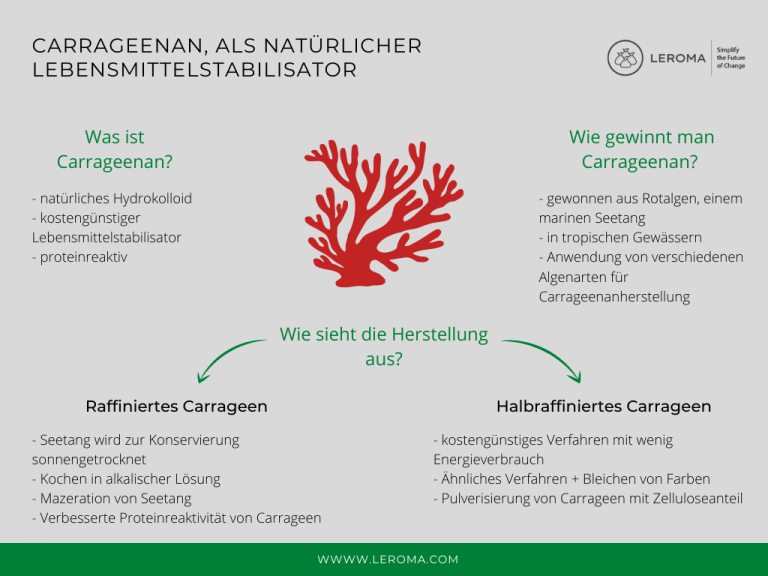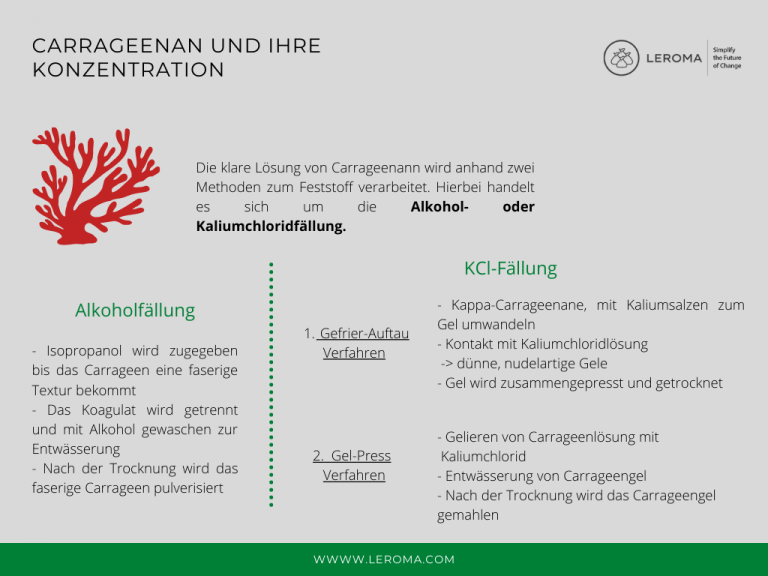Carrageenan ein natürlicher und vielseitiger Lebensmittelstabilisator
Carrageen ist ein natürliches Hydrokolloid und ein sicherer sowie kostengünstiger Lebensmittelstabilisator. Es kann Wassergels unterschiedlicher Textur bilden und ist proteinreaktiv, was es zu einem vielseitigen Lebensmittelstabilisator macht. Außerdem hilft es bei der Stabilisierung von gekochtem Schinken, Schokoladenmilch, Eiscreme und Bier, um nur einige Beispiele zu nennen.
Carrageen wird aus Rotalgen, einem marinen Seetang (Klasse Rhodophyceae), gewonnen. Sie wächst in tropischen Gewässern, hauptsächlich auf den Philippinen und in Indonesien, wo sie in Algenfarmen kultiviert und ganzjährig geerntet wird. Die am häufigsten verwendeten Algenarten für die Carrageenherstellung sind Eucheuma cottonii (für Kappa-Carrageenan) und Eucheuma spinosum (für Iota-Carrageenan).
Herstellungsverfahren Raffiniertes Carrageen E 407
Nach der Ernte wird der Seetang zur Konservierung sonnengetrocknet.
Im ersten Produktionsschritt wird der Seetang gewaschen, um anhaftende Salze und Sand zu entfernen.
Anschließend wird der Seetang in einer alkalischen Lösung (Natriumhydroxid oder Calciumhydroxid) gekocht. In diesem Schritt wird der Seetang mazeriert und das Carrageen wird in der Extraktionslösung aufgelöst. Außerdem findet in diesem Stadium die chemische Reaktion statt, die die Geliereigenschaften und die Proteinreaktivität des Carrageens verbessert.
Nicht gelöste Algenreste werden durch Filtration oder Zentrifugation von der Extraktionsmischung getrennt. In diesem Stadium enthält die Lösung bereits ca. 1-2 % Carrageenan. Die filtrierte Carrageen-Lösung wird auf eine endgültige Carrageen-Konzentration von ca. 2-3 % gebracht.
Der Verarbeiter hat nun eine klare Lösung von Carrageenan und es gibt zwei Methoden, es als Feststoff zu gewinnen - entweder durch Alkohol- oder Kaliumchloridfällung (KCl-Fällung).
1. Alkoholfällung
Bei der Alkoholmethode wird Isopropanol zugegeben, bis das gesamte Carrageen in der Lösung als faseriges Koagulum ausgefällt ist.
Das Koagulat wird dann mit einer Zentrifuge oder einem Sieb abgetrennt, gefolgt von mechanischem Pressen, um überschüssiges Lösungsmittel zu entfernen, und mit mehr Alkohol gewaschen, um es weiter zu entwässern. Nach der letzten Wäsche wird das Koagulum getrocknet und der Alkohol recycelt.
Das faserige Carrageen aus dem Trockner wird dann zu einem Pulver gemahlen und auf die gewünschte Partikelgröße gesiebt.
2. KCl-Fällung
a) Gefrier-Auftau-Verfahren
Das KCl-Verfahren beruht auf der Fähigkeit der Kappa-Carrageenane, mit Kaliumsalzen ein Gel zu bilden.
Für das Gefrier-Auftau-Verfahren wird die Carrageenlösung durch feine Löcher in eine Kaliumchloridlösung gedrückt. Bei Kontakt mit Kaliumchlorid bilden sich dünne, nudelartige Gele. Diese Gele werden gesammelt, mit mehr Kaliumchlorid gewaschen und gepresst, um Flüssigkeit zu entfernen, und dann eingefroren.
Beim Auftauen scheidet sich Wasser aus dem Gel aus (Synärese), das Carrageen-Gel wird erneut mit Kaliumchlorid gewaschen, zerkleinert und in einem Heißlufttrockner getrocknet.
b) Gel-Press-Verfahren
Bei dieser zweiten Methode wird die Carrageenlösung unter Zugabe von Kaliumchlorid in Tanks von mehreren hundert Litern zum Gelieren gebracht. Die Gele werden in Tücher eingewickelt und das Wasser wird durch Druckausübung aus dem Gel herausgepresst. Nach mehrstündigem Auspressen wird das vorgetrocknete Gel zerkleinert, in einem Heißlufttrockner getrocknet und auf eine geeignete Partikelgröße vermahlen.
Herstellungsverfahren halbraffiniertes Carrageen PES (verarbeitete Eucheuma-Alge) E 407a
Dieses kostengünstigere Verfahren verbraucht deutlich weniger Energie. Die ersten Schritte sind ähnlich. Aber während des alkalischen Kochens bleibt die Zellstruktur der Algen intakt.
Danach wird der Seetang entweder mit Hypochlorid oder Peroxid gebleicht, um Pigmente und dunkle Farbe zu entfernen. Das anschließende Waschen entfernt Bleichmittel, Proteine und unerwünschte Bestandteile.
Übrig bleiben das Carrageen und die aus Zellulose bestehenden Zellwände, die getrocknet und zu einem Pulver vermahlen werden.
Dieses so entstandene "halbraffinierte" Carrageen-Pulver enthält bis zu 15 % Zellulose und kann daher keine transparenten Gele, sondern trüb opalisierende Gele ergeben.



